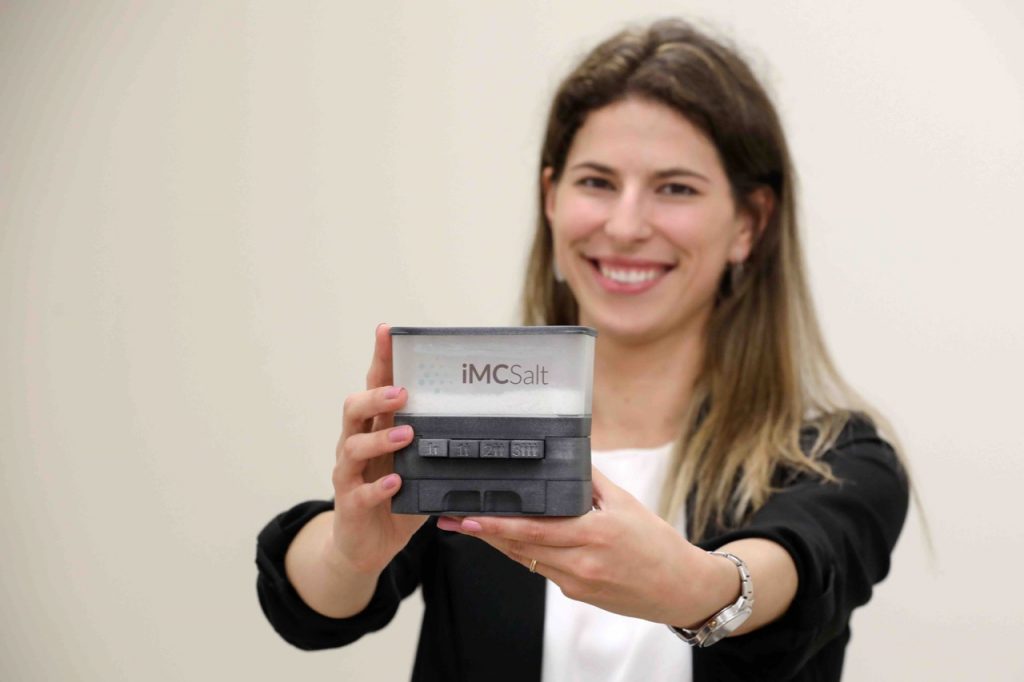Researchers at the University of Porto applied this summer for a patent to develop a smart salt shaker that calculates, in seconds, the amount of salt recommended by the World Health Organization (WHO) to cook family meals.
The first version of the prototype, named ‘Salt Control’ “weighs 328 grams and is 18 centimeters (cm) long, 12 cm high, and 8.3 cm wide,” said Carla Gonçalves, principal researcher at iMC SALT, a scientific project that received “233,000 euros” supported from community funds.
To the naked eye, the prototype salt controller is a plastic box that looks like a traditional salt shaker. But in fact, the hi-tech device is considered smart because it calculates the salt recommended by WHO.
When a button is pressed, it injects into a half-dozen centimeters drawer the amount of salt needed to prepare a one to three-liter soup and or to season the rest of the ingredients for the meal.
“This equipment helps because it already has the doses previously set. The person selects the button corresponding to the number of family members to prepare the meal, and has the child dose and the adult dose, ”explained Carla Gonçalves, a researcher at the Faculty of Nutrition and Food Sciences, University of Porto (FCNAUP) and primary responsible for the creation of the salt controller.
With this invention, the cook at home will not have to worry about using too much salt in the diner food, because the dose is predefined with algorithms and then just clicking the right button.
The new equipment, which may hit the market in 2023, will help to fulfill the dietary recommendations for WHO salt sodium intake of up to five grams per day, with the help of an internal mechanism with a blade and special springs.
To help create the mechanical process, FCNAUP partnered with the Institute of Science and Innovation in Mechanical Engineering and Industrial Engineering (INEGI) at the University of Porto, always bearing in mind that salt has a “very own behavior”, because with moisture clumps the grains and crystals are not equal, explained Carla Gonçalves.
In a second phase of the project, the objective is to know if the smart salt shaker will have an impact on the health of families.
“We will understand how the equipment enters the families at the time of cooking, which implies in terms of taste,” told Lusa Pedro Moreira, a professor at FCNAUP and also a member of the research team.
The next step of the IMCSalt project is, therefore, to carry out a clinical intervention with “260 Portuguese families” to use a replica of that special salt shaker for two months at home.
The new ‘made in Portugal’ device could have a ‘major health impact because it adds value in preventing the development of disease, as well as adding value to patients suffering from hypertension,’ says Carla Gonçalves.
In addition to Carla Gonçalves and Pedro Moreira from FCNAUP and INEGI, the project also has partnerships with the Occupational Health Service of Hospital São João do Porto, as well as the National Institute of Health Doctor Ricardo Jorge (INÇA) and the Instituto of Biomedical Sciences Abel Salazar – U.Porto (ICBAS).
A study published a year ago in the journal Food & Nutrition Research and which Lusa reported at the time indicated that almost all Portuguese elderly (91.5% of men and 80% of women) ingest salt above WHO recommendations and have low levels. potassium
Another study from the University of Porto released four years ago found that almost all Portuguese children (93%) ingest salt above WHO recommendations, with children in Portugal consuming 17 grams of salt per day, or more than triple the number of children. values advised, and that 85% of the adolescents evaluated consumed excess salt, with some ingesting 22 grams of salt per day through pizza, sausage, pastries.
Ver artigo em Português
Investigadores Portugueses Inventam Saleiro Inteligente
Porto, 04 jul 2019 (Lusa) – Investigadores da Universidade do Porto pediram este verão a patente para uma espécie de saleiro inteligente que calcula, em segundos, a quantidade de sal recomendada pela Organização Mundial de Saúde (OMS) para confecionar refeições em família.
A primeira versão do protótipo, batizado de ‘Salt Control’, pesa 328 gramas e tem “18 centímetros (cm) de comprimento, 12 de altura e 8,3 de largura, descreveu Carla Gonçalves, investigadora principal do iMC SALT, projeto científico que recebeu apoio de “233 mil euros” fundos comunitários.
A olho nu, o protótipo do controlador de sal, é uma caixa de plástico parecida com um saleiro de cozinha tradicional.
Mas, na verdade, o aparelho ‘hi-tech’ (alta tecnologia) é considerado inteligente, porque calcula o sal recomendando pela OMS.
Ao carregar-se num botão, é injetada, numa gaveta com meia dúzia de centímetros, a quantidade de sal necessária para preparar uma sopa de um a três litros e ou para temperar o resto dos ingredientes para a refeição.
“Este equipamento ajuda, porque já tem as doses previamente definidas. A pessoa seleciona o botão correspondente ao número de elementos da família para a qual vai confecionar a refeição, e tem a dose de criança e a dose de adulto”, explicou Carla Gonçalves, investigadora da Faculdade de Ciências da Nutrição e Alimentação da Universidade do Porto (FCNAUP) e a principal responsável pela criação do controlador de sal.
Com esta invenção, o cozinheiro, ou a cozinheira, de serviço lá em casa não terá de se preocupar se está a usar sal em excesso na comida para os comensais, porque a dose é predefinida com algoritmos e depois basta clicar no botão certo.
O novo equipamento, que pode chegar ao mercado em 2023, vem ajudar a concretizar as recomendações alimentares da ingestão de sódio de sal da OMS que é de até cinco gramas por dia, com a ajuda dum mecanismo interno com uma lâmina e umas molas especiais.
Para ajudar a criar o processo mecânico, a FCNAUP teve como parceiro o Instituto de Ciência e Inovação em Engenharia Mecânica e Engenharia Industrial (INEGI) da Universidade do Porto, tendo sempre em conta que o sal tem um “comportamento muito próprio”, porque com a humidade aglutina os grãos e os cristais não são iguais, explicou Carla Gonçalves.
Numa segunda fase do projeto, o objetivo é saber se o saleiro inteligente vai ter impacte na saúde das famílias.
“Vamos perceber de que forma é que o equipamento entra nas famílias no momento de cozinhar, o que é que isso implica em termos de paladar”, conta à Lusa Pedro Moreira, docente da FCNAUP e também elemento da equipa investigadora.
O próximo passo do projeto IMCSalt é, portanto, realizar uma intervenção clínica junto de “260 famílias portuguesas” para que utilizem, durante dois meses, em casa uma réplica daquele saleiro especial.
O novo aparelho ‘made in Portugal’ poderá ter um “grande impacto em termos de saúde, porque acrescenta uma mais valia na prevenção do desenvolvimento de doença, bem como é também uma mais valia para os pacientes que sofrem de hipertensão, considera Carla Gonçalves.
Para além de Carla Gonçalves e de Pedro Moreira da FCNAUP e do INEGI, o projeto conta também com as parcerias do Serviço de Saúde Ocupacional do Hospital São João do Porto, bem como do Instituto Nacional de Saúde Doutor Ricardo Jorge (INÇA) e do Instituto de Ciências Biomédicas Abel Salazar – U.Porto (ICBAS).
Outros artigos no Feel Portugal
- Fadista Sara Correia Performs at 2023 Lowell Folk Festival
- An Evening of Fado with Maria Emília and Helder Moutinho in Lowell, MA
- Fado Museum, in Lisbon, inaugurates “Celeste” exhibition, a tribute to fado singer Celesta Rodrigues (1923-2018)
- INTERVIEW: “Ice Merchants” Producer Needs Funding for Final Step Toward the Oscars
- Portuguese communities in North America reject SATA’s “abusive” prices
Um estudo publicado há um ano na revista Food & Nutrition Research e que a Lusa noticiou na altura indicava que quase todos os idosos portugueses (91,5% dos homens e 80% das mulheres) ingerem sal acima das recomendações da OMS e têm níveis baixos de potássio.
Um outro estudo da Universidade do Porto divulgado há quatro anos concluía que quase todas as crianças portuguesas (93%) ingerem sal acima das recomendações da OMS, havendo crianças em Portugal a consumir 17 gramas de sal por dia, ou seja, mais do triplo dos valores aconselhados, e que 85% dos adolescentes avaliados consumiam sal em excesso, havendo quem ingira 22 gramas de sal por dia através de pizzas, chourição e pastelaria.
CCM // MSP


